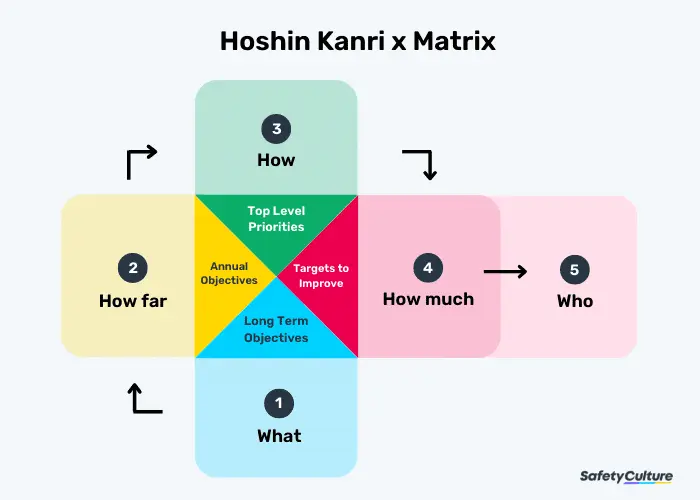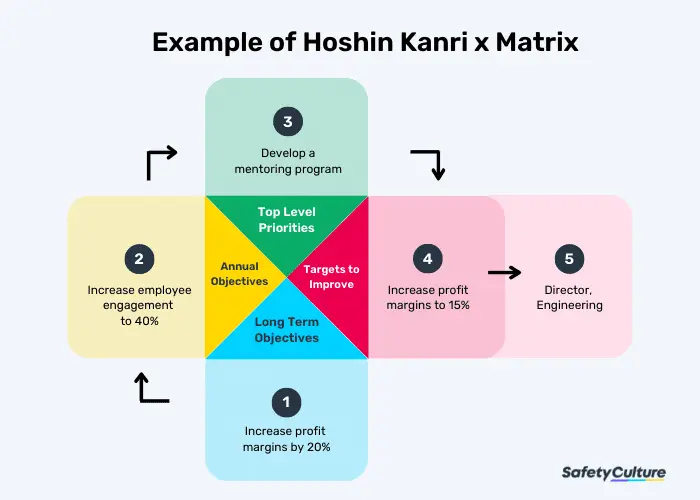What is the Hoshin Planning Process?
Hoshin Planning Process is a method businesses can use to set and achieve strategic objectives. The goal of the process is to develop a shared vision and set of goals that can guide the organization’s decision-making. The entire organization participates in a brainstorming session where ideas are shared. These ideas are then compiled and used to create a mission statement. From there, the organization develops a series of objectives to help it achieve its mission. The Hoshin Process effectively ensures that everyone in an organization is working towards the same goals.
Continuous Improvement: An Integral Aspect of Hoshin Kanri
Hoshin Kanri‘s planning isn’t limited to top-down implementation. It features built-in continuous improvement procedures, essential to ensuring the method’s success. These are Catchball and PDCA, two of the process tools.
Hoshin Kanri Catchball
The Hoshin Planning, as previously said, is a top-down approach. It is a collaborative effort between a manager and a subordinate who must agree on the best set of goals. If managers push people into accomplishing particular business objectives without obtaining feedback, they risk demotivating them and overlooking critical details.
The advantage of communicating the objectives with the people working on them is that they will consider the specifics more thoroughly than management. In practice, this is what Catchball is all about. Having well-communicated, realistic, and agreed-upon goals is critical for fostering ownership and enthusiasm, establishing a beneficial feedback loop, and increasing execution quality.
Plan-Do-Check-Act (PDCA)
The Deming Cycle is a method for improving quality that Deming first conceived as a continuous improvement method. It has four stages:
- Plan – plan solutions and forecast their possible results
- Do – carry out the plan
- Check – validate the effectiveness of the implemented solutions
- Act – if successful, standardize the results across the organization and repeat the sequence
The PDCA approach, which is a scientific method for continuous improvement, necessitates the use of some specialized techniques:
- The PDCA cycle is only effective if you make it a continual effort. PDCA is likely to improve if you try it a few times but will be of limited value unless you iterate regularly.
- It is critical to conduct the experiments in a controlled setting. If the findings do not yield useful information, they cannot serve as a baseline for a future PDCA cycle.
- Always aim to reach the system optimum, not the local optimum, while running PDCA experiments. Local optimums may be harmful on a broader scale since they might result in excessive Work In Progress (WIP).
Why Hoshin Kanri?
The greatest problems that large corporations face are misalignment and human resources, where hundreds of employees do many different tasks every day. Small businesses may also struggle, where work is much more rapid, and the big picture may get lost.
If implemented correctly, the Hoshin Process compels the leadership team to establish a vision. Setting breakthrough goals encourages a cascade of collective goals and provides the necessary leverage to achieve success. To put it another way, Hoshin Kanri bridges the gap between strategy and execution by promoting alignment and concentration.
How to Implement Hoshin Kanri
The Hoshin Kanri process utilizes a template called the Hoshin X Matrix. The template visually depicts the relationship between objectives, strategies, and tactics. The X matrix is a powerful tool for tracking the progress of an organization’s Hoshin Kanri implementation.
Below is what the X matrix looks like.

Hoshin Kanri X Matrix
And here’s what it looks like when it’s filled in:

Example of Hoshin Kanri X Matrix
Mapping everything on the X matrix allows you to see the big picture and understand how each tactic contributes to the overall goal.
Understanding the Hoshin Kanri X Matrix
Setting your yearly strategic goals is generally when the Hoshin Matrix comes in. The X matrix aids in goal deployment planning. By establishing alignment and focus, the Hoshin Matrix will connect strategy with implementation by eliminating the gap.
The X matrix may look too complex, especially to those who have never heard of Hoshin Kanri, but it is quite simple. A Hoshin Kanri X matrix is a one-page document that outlines objectives, tactics, significant projects (initiatives), and owners. Each quadrant includes the following:
Long-Term Goals (South)
It describes your long-term objectives supporting the company’s overall policy or directional shift. Long-term goals set a standard for where an organization wants to go.
Annual Objectives (West)
Establishing long-term goals involves asking: ‘What do you hope to accomplish this year?’ There is an intersection between long-term and annual goals.
Top-Level Priorities (North)
It expands on the various tasks you want to perform each year to meet your annual goals. Switching to energy-efficient lighting, or establishing a cycle-to-work program, are examples of activities at the intersection of the matrix.
Targets to Improve (East)
It establishes numerical goals to achieve the top-level goals. As a result, organizations strive to meet these targets within a year, allowing them to keep track of which priorities influence which targets and whether any plans directly relate to the long-term goals.
Responsibility
The people assigned to execute the specified activities/goals are on the diagram’s far-right side.
Lastly, the X matrix template illustrates the relationships between the activities within each section.
The Seven Steps of Hoshin Planning
The Hoshin 7-step process, which aims to bridge the gap between strategy and execution, has the following structure:
Step 1: Establish Organizational Vision
The first step is to establish a shared vision for the organization. It involves creating a mental picture of where the company wants to be in the future. It uses the following questions as a guideline:
- What are the current processes in place that enable objectives to be established and carried out?
- Is there any existing long-term strategy in place?
- Is there a mission and vision statement?
- What are the present organizational level structure and day-to-day management system?
Step 2: Develop Breakthrough Objectives
Define your three- to five-year breakthrough goals next. Then divide these objectives into components depending on your company’s structure. For example, if your company has a facility in North America, Europe, and South Africa, the three- to five-year goals must be divided into objectives for each geographic region.
It may also be possible to divide your company into functional departments like production and quality. In this case, break down your 3-5 year objectives for each team and communicate them to the team managers.
Step 3: Develop Annual Objectives
Plan your next 12 months to ensure you meet your 3-5 year goals. Suppose you want to introduce a new product in the next three years. This year, your goal may be to finish a market research study and define product requirements.
Step 4: Cascade Goals Throughout the Organization
Use the catchball technique to communicate with various parties in an ongoing exchange of information regarding what it will take to achieve specific goals. Assign department, team, and individual objectives once you’ve determined what you need to accomplish in the year.
Step 5: Implement Annual Objectives
As you go through your monthly and annual objective reviews, you may discover that you’ve missed some of them. Prepare to solve issues to fulfill missed targets. Create a Plan-Do-Act-Check approach to identify and remove any obstructions preventing you from achieving your goals.
Step 6: Monthly Review
Companies frequently overlook this step, and the Hoshin Kanri process helps avoid this error. Conduct monthly reviews to ensure the project’s progress is on track. Make a plan for checking in on progress every month. Begin by creating personal evaluations first. Then create a project and team-wide/departmental review procedures.
Step 7: Annual Review
After the yearly cycle, a comprehensive examination of the year’s goals shows how far ahead or behind the organization is in achieving its stated objectives and how to move forward.
Step back and think about what worked and didn’t work during the process. The goal is to assist your company in moving forward on future breakthrough goals.
Create Your Own Hoshin Planning Template
Eliminate manual tasks and streamline your operations.
Get started for FREEDisadvantages of Hoshin Kanri
After we’ve looked at the advantages of Hoshin Kanri, it’s time to take a step back and look at some of the disadvantages.
No Room for Error
The most significant disadvantage of Hoshin Kanri is that there is no room for error. This planning method requires a high level of commitment from everyone involved.
Requires a Lot of Time and Resources
Another disadvantage of Hoshin Kanri is that it requires a lot of time and resources to implement correctly. Small businesses with limited resources may not be able to implement it properly.
Can Be Inflexible
Hoshin Kanri can also be inflexible, making it difficult to adapt to changing circumstances.
Not Everyone May Be on Board
Not everyone in the organization may be in favor of the Hoshin Kanri planning process. It can make it challenging to get everyone working towards the same goal.
Can Be Overwhelming
For some people, the Hoshin Kanri planning process can be overwhelming. There is a lot of information, and it can be challenging to see the big picture.
Question to Ask When Using Software for Hoshin Planning
If you’re planning to use software for Hoshin Planning, you should ask yourself whether it can handle the Hoshin X matrix. As described earlier, the Hoshin X matrix is a one-page visual of your objectives, measures and targets, measure programs, and corrective action items.
Your software should allow you to input this information and generate a visual representation. It will help you see the big picture and ensure everyone is on the same page.
A software solution should also make it easy to update the matrix as things change. After all, Hoshin Planning is an ongoing process, and you’ll need to be able to adjust your plan as your objectives, measures, and targets change.
Finally, you’ll want to ensure that the software you choose is easy to use. The last thing you want is your Hoshin Planning process to be bogged down by complicated software.




